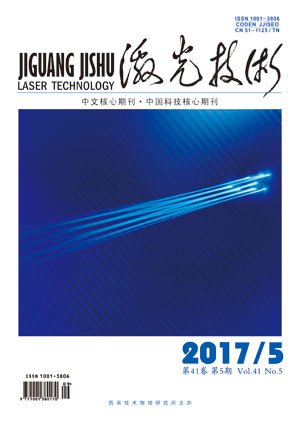HTML
-
激光诱导高次谐波(high-order harmonic generation, HHG)是强激光物理领域中最重要的现象之一。由于其在制备极紫外(extreme ultraviolet, EUV)以及X射线光源中有巨大的应用价值,过去20年中人们已对高次谐波进行了大量研究[1-4]。一般来说,激光与原子相互作用产生高次谐波可以通过电离-加速-回碰三步模型[5]来描述。
原子谐波的最主要用途之一是用来输出高光子能量、高强度的单个阿秒脉冲。因此,研究人员提出了许多有效方法来完成这一目标,例如:(1)电离门或偏振门技术[6-7];(2)非共线谐波发射[8];(3)多色场控制方案[9-10];(4)啁啾场调制[11];(5)中红外激光场控制方案[12];(6)单极场控制方案[13];(7)空间非均匀场调制方案[14-15]等。虽然谐波截止能量在上述方案中会有明显延伸,但是谐波强度在谐波截止能量附近会出现明显下降,这并不利于输出高强度的阿秒脉冲。因此,如何在保证谐波强度足够强的同时来延伸谐波截止能量成为了人们关注的重点。例如:ZHANG等人[16]和FENG等人[17]利用He+离子叠加态作为初始态在双色激光场以及啁啾激光场作用下获得了一系列强度被增强6个数量级的阿秒脉冲。ISHIKAWA[18]、LI等人[19]、DU等人[20]、FENG等人[21]利用超快紫外光源激发He原子以及He+离子,随后与双色场或者啁啾场相互作用,获得了一系列谐波增强范围在7个数量级到17个数量级的谐波光谱。虽然谐波强度在上述理论方案中可以被有效增强,但是实验上实现却比较困难。例如:(1)如何获得稳定的叠加态作为初始态?(2)如何控制紫外光源有效激发He原子或He+离子?
最近,一种利用啁啾场或者多色场调制激来增强谐波强度的方案得到了学者们的关注。相比之前的理论方案,该方案更容易在实验上实现。例如:实验方面,WEI等人[22-23]利用800nm主频场与其2阶、3阶谐波场的组合场与惰性气体相互作用后,可以把单一的高阶谐波增强1~2个数量级; 理论方面,WANG等人[24]利用强场近似方法解释了WEI等人获得的谐波增强的实验结果。LARA-ASTIASO等人[25]利用负向啁啾场与H2+相互作用使谐波截止能量附近强度获得2~3个数量级的增强。
因此,鉴于上述原因,本文中提出一种利用负向啁啾激光场与半周期激光场的组合场的方式来同时增强谐波强度和延伸谐波截止能量的方法。获得了强度增强1个数量级的46as的脉冲。
-
激光场与He原子作用的3维薛定谔方程为[26]:
式中,V(r)=-1.535/r是He原子的库伦势,r为电子坐标,t为激光作用时间,φ(r, t)为电子波函数。激光场E(t)=Eexp[-4(ln2)t2/τ2]cos(ω1t+αt2/2)+EHCP(t),采用原子单位制(atomic unit, a.u.), 其中ω1,E和τ分别为激光场的频率、振幅和脉宽; α为啁啾参量,α>0.0表示正向啁啾;α < 0.0表示负向啁啾。EHCP(t)=kθ(t-τd)E{400(t-τd)3exp[-8(t-τd)/τHCP]/τHCP3-0.004(t-τd)5exp[-(t-τd)/τHCP]/τHCP5}为半周期激光场,其中kE,τHCP和τd分别为半周期激光场的振幅(k为比例系数)、脉宽以及与主频场的延迟时间。θ(t-τ)为阶跃函数。偶极加速度可以表示为[27]:a(t)=〈φ(r, t)|-∂V(r)/∂r+E(t)|φ(r, t)〉。高次谐波谱图可表示为:$S\left( \omega \right) = {\left| {{{(2{\rm{ \mathsf{ π} }})}^{ - 1/2}}\int_{_0}^{{T_{{\rm{total}}}}} {a(t){{\rm{e}}^{ - {\rm{i}}{\omega _1}t}}{\rm{d}}t} } \right|^2}$,Ttotal为总作用时间,ω表示谐波辐射频率。小波变换时频分析可以表示为[28]:$A\left( {t,\omega } \right) = \smallint a\left( {{t^\prime }} \right)\sqrt {{\omega _1}} W({\omega _1}\left( {{t^\prime } - t} \right)){\rm{d}}{t^\prime }$,其中t′为时频变换后的积分时间变量,W(x)=ξ-1/2eixe-x2/(2ξ2),ξ = 15为小波变换数值。阿秒脉冲强度Iatto(t)可以通过叠加谐波光谱获得:Iatto(t)=${\left| {\sum\limits_q {{{\left( {\smallint a(t){{\rm{e}}^{ - {\rm{i}}q{\omega _1}t}}{\rm{d}}t} \right)}^{{{\rm{e}}^{{\rm{i}}q{\omega _1}t}}}}} } \right|^2}$,q为谐波次数。
-
图 1a是He原子与激光脉宽τ=5fs、激光波长λ= 800nm、激光场场强I=3.5×1014W/cm2的激光场相互作用后辐射谐波的谱图。由图可知,在无啁啾调制下(α=0.0),He原子谐波辐射图呈现双平台结构,谐波强度在截止能量附近的第二平台区有明显下降趋势,其强度比第一平台区减小1个数量级。众所周知,要获得光子能量更高的阿秒脉冲,选择谐波截止能量附近的谐波进行叠加是有效的方法。但在无啁啾调制激光场驱动下, 谐波光谱在截止能量附近强度有明显下降,这显然不利于高强度阿秒脉冲的输出。因此,本文中采用正负向啁啾激光场来试图调制谐波截止能量的强度。分析图 1a可知,当引入负向啁啾参量时(α=-0.0002),谐波光谱呈现单一平台结构,其截止能量附近强度比无啁啾调制下增强1个数量级; 当引入正向啁啾参量时(α=0.0002),谐波光谱仍呈现双平台结构,并且第二平台区谐波强度与无啁啾情况相比又有减小,显然更为不利于增强输出脉冲的强度。图 1b~ 图 1d中给出上述3种啁啾场下谐波辐射的时频分析图,其中T代表激光光学周期。由图可知,5fs超短激光脉冲作用He原子会出现3个主要的谐波辐射过程,记为P1,P2,P3。其中P1,P3辐射过程所产生的能量几乎一致(见图 1b),因此在谐波光谱上呈现双平台结构。当引入正向啁啾参量时(见图 1c),P1辐射过程的截止能量被增大,但是P1过程的强度要远小于P2和P3过程的强度(大约小3~4个数量级),其在谐波光谱上的贡献与P2和P3过程相比几乎可忽略不计。因此在谐波光谱上依然可观测到2个平台区,且由于P1辐射强度被明显减弱,因此导致图 1a所示谐波强度减小。当引入负向啁啾参量时(见图 1d),P3辐射过程的截止能量被增大,而且其辐射强度与无啁啾情况比较并没有衰减,这导致谐波能量大于45ω1时有P2和P3 2个谐波辐射过程贡献产生,这就是图 1a所示谐波第二平台区强度增大的原因。
图 2a~图 2c中分别给出无啁啾调制和正负向啁啾调制后的激光包络图以及电子电离几率。由图 2可知,电离主要发生在激光瞬时振幅附近,即I1,I2,I3,I4。由谐波辐射的半经典三步模型可知,电子在电离后的半个周期内会在激光场中加速并与核子发生碰撞,其辐射谐波能量与半周期的振幅,瞬时波长呈正比。分析图 1b~图 1d及图 2a~图 2c可知,谐波辐射过程P1~P3是电子在电离点I1~ I3电离后在后续半个周期内发生加速-回碰所产生的(因电离点I4之后的半周期强度较弱,故其辐射谐波能量较低,这里不考虑它的作用)。分析激光包络图可知,随着正负向啁啾参量的引入,激光波形分别在前半段[-2T~-0.5T]和后半段[0.5T~2.0T]展宽,即激光波长被瞬时增大,因此导致图 1c和图 1d中辐射能量过程P1和P3的能量增大。但由于电离几率在I1处非常小,所以导致谐波辐射过程P1的强度非常弱。相反,I3处的电离几率与无啁啾情况电离几率大小类似,因此谐波辐射过程P3的强度并未被减弱。
图 3a中给出负向啁啾激光场(α=-0.0002)与半周期控制场的组合场驱动He原子产生谐波的特点。半周期控制场场强、脉宽、延迟时间分别为kE=-0.3E,τHCP=2.0fs和τd=0.1T。由图可知,随着半周期控制场的加入,谐波截止能量得到展宽,并且谐波强度并没有减弱,这非常有利于增强阿秒脉冲的强度。图 3b中给出组合场下谐波辐射的时频分析图。由图可见,谐波辐射过程P3的辐射能在组合场下被明显增大,而且其强度与单色负向啁啾场下所产生的辐射过程P2和P3几乎一致,因此谐波光谱截止能量在强度不变的情况下得到了延伸。图 3c是负向啁啾激光场(α=-0.0002)、半周期控制场、组合场的激光包络图及电子在组合场下的电离几率。在半周期控制场引入后,组合场在0.25T~0.75T处的瞬时振幅明显被增大,导致电子在I3处电离后可在加速过程中获得更多的能量,进而可以辐射出能量更高的谐波,这就是图 3b中辐射能量过程P3延伸及图 3a所示谐波截止能量增大的原因。
由图 3b分析可知,当引入的半周期激光场延迟时间为τd=0.1T时,谐波截止能量在强度不变的情况下有明显延伸,并且当谐波能量大于70ω1时,只有单独的谐波辐射过程P3对谐波光谱有贡献作用,这有利于单个阿秒脉冲的输出。因此,通过适当叠加75ω1到85ω1次谐波,可获得1个46as的脉冲。由于其谐波强度(75ω1~85ω1)要比无啁啾情况下获得的谐波强1个数量级,因此获得的脉冲强度也比无啁啾情况下获得的脉冲强1个数量级,如图 4所示。
-
利用负向啁啾激光场以及半周期控制场对谐波辐射截止能量及强度进行了调控。计算结果表明,当激光引入负向啁啾参量时,谐波截止能量附近的强度与无啁啾参量时相比增强了1个数量级。随后,适当引入半周期控制激光场,谐波截止能量在强度不变的情况下得到有效延伸。最后,叠加谐波谱上的谐波,可获得一个46as的脉冲。该脉冲强度与无啁啾参量下获得的脉冲相比增强了1个数量级。由于利用啁啾场或者多色场方案增强谐波以及阿秒脉冲强度已在实验上被证实[22-23],故所提出的改进方案(利用负向啁啾激光场以及半周期控制场延伸及增强谐波辐射截止能量)为实验获得高强度阿秒脉冲提供了另一种方法。
感谢中国科学院大连化学物理研究所韩克利研究员所提供的计算资源。

 Map
Map








 DownLoad:
DownLoad:


